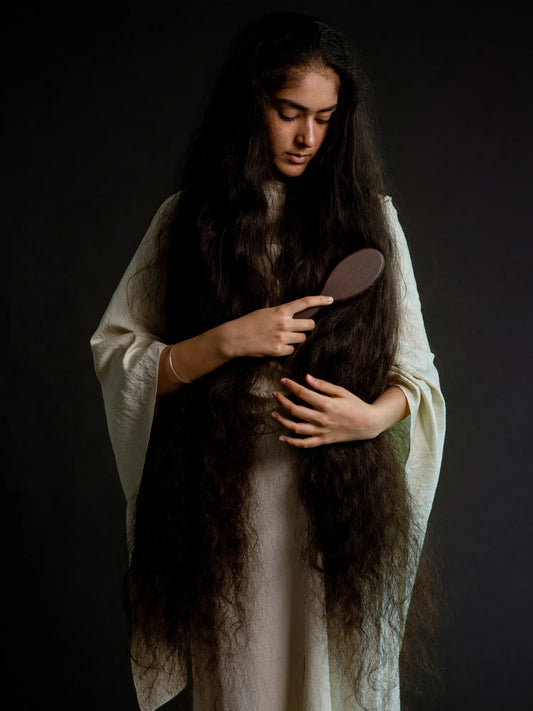
The fern's quiet perseverance stirred a contemplation within me about the vast tapestry of time and the origins of things. Every existence, every idea, every ritual, had an origin. I was suddenly struck by the profound realisation of how much of this rich tapestry we've misplaced, how many threads connecting us to our ancestors have been lost in the labyrinth of history.
It wasn't just about the grand narratives or revolutionary discoveries. No, it was the small, humble rituals, performed day in and day out, that intrigued me. These seemingly insignificant practices held a mirror to their lives and, by extension, ours. These were the silent whispers of our shared past, reverberating through the ages.
One such whisper echoed the rituals of self care. A simple act that has spanned millennia. How did our ancestors, devoid of modern conveniences, attend to themselves? This question, born in the tranquillity of a bath, compelled me to embark on a journey – a journey into the mists of history to trace an outline of the evolution of our relationship with nature, and our bodies.
Here I’ll share just a single excerpt from my larger discovery and hopefully, in time be able to share all the wonderful things I’ve been able to learn about our shared past. I start with the place I am now privileged to call home. The lands of the aboriginal people of Australia.
Australia's Ancestral Gift: The Wisdom of Aboriginal Hair Care
The Aboriginal people of this land carry a legacy that spans an astonishing 50,000-65,000 years. Their culture, nurtured and passed down through countless generations, is the oldest known civilisation on our shared Earth.
In the Aboriginal worldview, the land is more than a provider of resources. It is a living, breathing entity, a web of life deserving of deep respect and mindful stewardship. This way of seeing, of being, is a reminder that we are not alone or special in the world; we are kin to all of life.
Take the emu, for example, a flightless bird that native to the Australian landscape. The Aboriginal people discovered the healing powers of emu oil, a potent, natural substance rich in essential fatty acids. They learned that the oil, when applied to the skin and hair, imparted a deep, nourishing conditioner.
Picture a group nestled around the nurturing warmth of a fire, their faces glowing in the flickering light against the backdrop of an impenetrable darkness. In their hands, they cradle shells brimming with precious oils, nature's own concoction, rendered from emu and kangaroo fat, imbued with fragrant eucalyptus leaves, and the healing Melaleuca quinquenervia tree. These oils are the land's legacy, connecting each generation to the earth, its creatures, and their ancestors.
Now watch as the ritual unfolds, as fingers steeped in this aromatic oil tenderly work it into their hair. This simple act, repeated across the span of time, is much more than grooming. It's a ceremonial communion, a tangible connection to the land and its inhabitants, a tribute to their interdependence.
It's worth noting that their use of animal products was a practical choice as much as it was spiritual; in the absence of industrial agriculture, relying on the available animal fats for nourishment was a more ethically defensible choice. But even in its practicality, there was a deep reverence and respect. Each animal was viewed not as a mere resource, but as a fellow life, a kin. Their sacrifice was honoured and nothing was wasted.
Their understanding also extended to the boundless ocean, home to bountiful fish whose oils served as nourishment and a protective shield against the relentless assault of mosquitos. Picture the fluid movements as they anoint their skin with the oils, creating a protective layer against the twilight invaders. This practice was born from careful observation, deep respect, and mutual give-and-take with nature.
In the generous abundance of Australia's flora, the Aboriginal people found a plethora of hair care gifts. From the antioxidant-rich Kakadu plum to the Quandong, from the oil-bearing Macadamia nut to the nourishing Wattle seed - all contributed in their own ways.
Then there is the quiet grace of the tea tree, a native species as integral to Australia's rich biodiversity as the Aboriginal people themselves. It was they who first unveiled the tree's healing secrets, extracting its oil to treat skin conditions and enhance the health of their hair. Rich in terpinen, the oil boasts potent antimicrobial properties.
These ancient practices continue to resonate today, their wisdom echoing through modern hair care routines worldwide. However, as we incorporate these age-old secrets into our lives, it is crucial to honour their origins. We must remember to respect and safeguard the wisdom of the Aboriginal people, ensuring fair sharing of benefits derived from their traditional practices.














